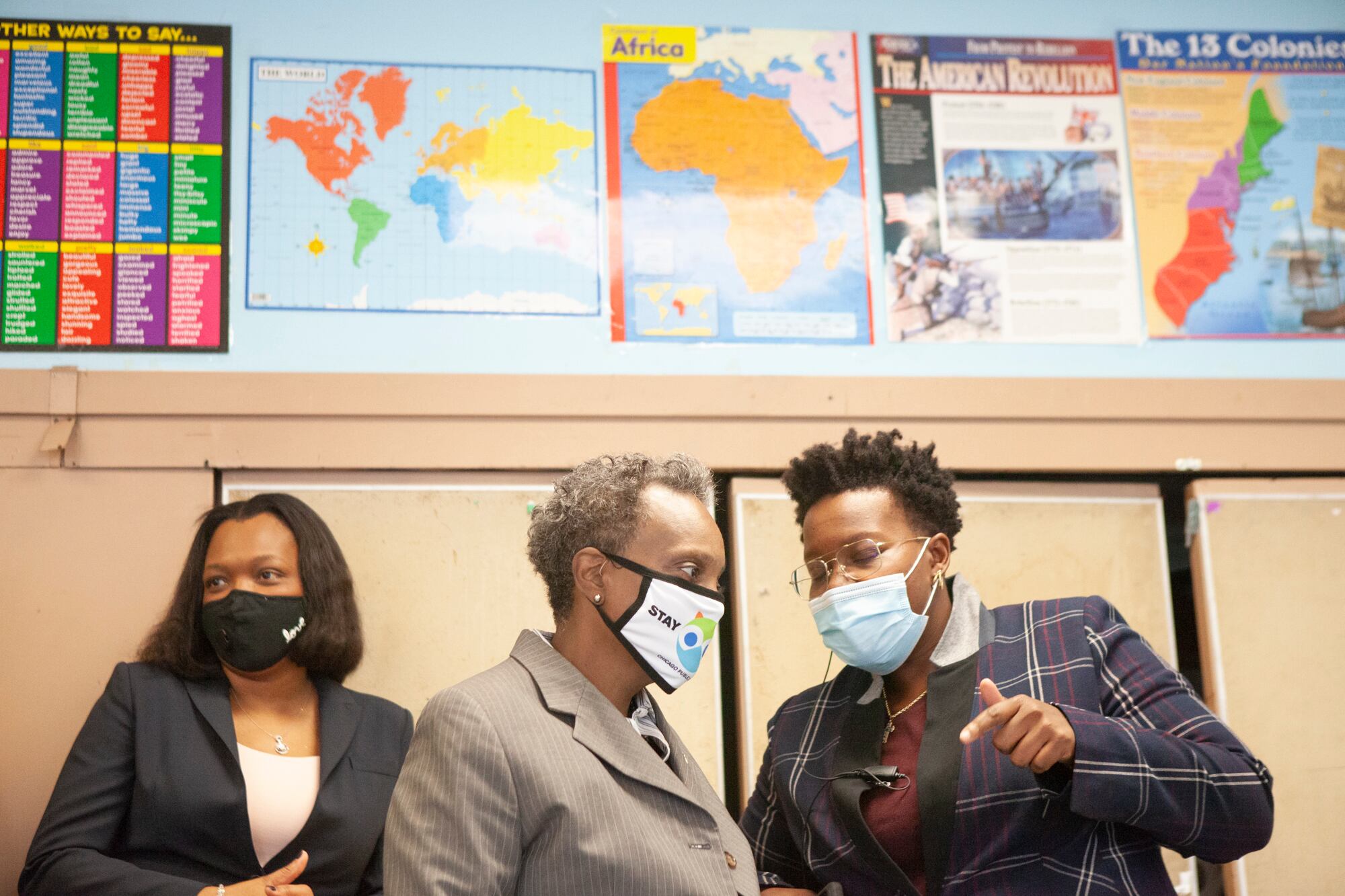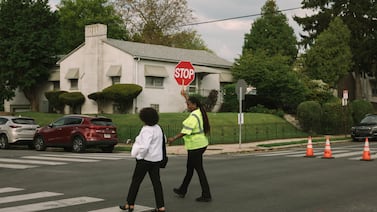One week after Chicago struck a fragile peace with its teachers union, fault lines have emerged over who gets to work from home, for how long, and why.
That’s because the hard-won contract between the city and the union appears to still leave some key matters open to interpretation. Among those issues: whether teachers have to report to school buildings if their students choose to continue learning remotely.
How district officials and union leaders work through a new spate of complications — and whether they can reach an agreement to reopen high schools — will be closely watched as Chicago tries to mend wounds from a reopening battle that captured national attention and split school communities. Officials have said they fear that lingering acrimony will drive families away from a district that reported worrisome enrollment losses already this year.
Instead of negotiations playing out at the district level, now it’s up to individual schools, and principals, to put into practice an agreement reached at a citywide level.
Schools chief Janice Jackson, speaking at a press conference last week as prekindergarten and some special education students returned to buildings, addressed the issue directly. “Recovery and healing is a critical part of [reopening schools],” she said. “I know a lot of that is going to start at the local level.”
One likely source of such conversations will be school-level safety committees that the agreement established to oversee safety complaints and weigh in on decisions about when a building may need to revert back to remote learning. Union President Jesse Sharkey pointed to them as tools to hold the district accountable.
It’s too early to tell if those groups will foster reconciliation or escalate tensions at schools.
For teachers going back into buildings, a long history of trying to bridge the gap between high-level promises and the view at their schools has made them apprehensive. Only a week since the agreement was signed, school-level concerns about interpreting the language are already playing out.
Social worker Brian Calhoun had been working in school buildings for several weeks this year when the mounting tensions over a reopening agreement between the district and union sent him home.
Calhoun supported the union’s push though he had willingly returned to working in person. But as the weeks went on, amid angry messages on social media, heated rhetoric from the city’s press conferences, and questions from his student’s families about when schools would reopen, Calhoun felt disheartened. The deal, when it finally happened, didn’t feel like a victory.
“We have something where there was nothing,” said Calhoun, who should be in the classroom this week. “But I don’t know if there is somebody who won in this.”
For educator Erin Young, the dynamic may have severed her relationship with the district permanently. A special education teacher at Luther Burbank Elementary, Young took an unpaid discretionary leave this year because she didn’t think she’d be able to get a health accommodation. She didn’t trust the district’s promise to provide safety measures in classrooms.
She said school administrations “say they’ll do this and that...But often, you can’t get toilet paper and hot water.”
Implementing remote work accommodations
Among the most contentious issues that the union and district negotiated was the question of accommodations: which educators may work remotely and why.
The agreement instructs schools to allow teachers and classroom staff “with no assigned in-person students on their roster or caseload” to work remotely when possible. However, it’s unclear whether this language refers to all teachers or only those with high-risk family members.
With about two out of three elementary students expected to stay remote for the third quarter, the hope was this would give schools some staffing flexibility while minimizing the number of educators who took unpaid leave to avoid in-person work. Of the 7,000 teachers and paraprofessionals the district called back to classrooms to teach prekindergarten and special education in January, officials originally said 2,000 asked for accommodations.
Now it is not clear which teachers this line applies to: those who had accommodations for high-risk family members, those previously denied accommodations, or any staff with no in-person students.
The union called that the district’s interpretation unduly narrow and wants the accommodation offered to all teachers who had no in-person students, if possible.
“We’re not just talking about a handful of schools,” Thad Goodchild, the union’s attorney, said. “This is the highest-profile dispute right now, but there is certainly a lot of other stuff there is confusion around.”
The district, in a statement, said the agreement only says teachers with accommodations would be provided the opportunity to work remotely “where is it operationally feasible.”
That “is the operative phrase,” said district spokesperson Emily Bolton. “The information being provided to CTU’s membership blatantly contradicts the language of the agreement.”
The fresh disagreement comes just before 62,000 kindergarten to 8th grade students that opted for in-person learning are supposed to return to classrooms for the first time in nearly a year. Teachers for kindergarten through fifth grade are supposed to return next week, with students returning March 1. Middle school students are supposed to follow the week after.
The agreement also includes plans for regular surveillance testing of teachers, weekly vaccine guarantees for union members, and more work-from-home accommodations.
Mayor Lori Lightfoot acknowledged the difficulty of the recent weeks, but said the teachers union had fomented anger among its members. She also warned, in a wide-ranging interview with The New York Times, that the union’s long-term goal was to “take over not only Chicago Public Schools, but take over running the city government.”
The union, proud of its broad social justice agenda, has continued to criticize the agreement. Its statement on the eve of the deal’s ratification called the agreement “a stain on the record of their [district and city] administration” — even while admitting it was the best it could win at the bargaining table. “This plan is not what any of us deserve. Not us. Not our students. Not their families,” it read.
Experts have said Chicago’s agreement might be the most detailed, far-reaching school reopening agreement in the country. And while it includes a side letter restoring access for the 100 teachers locked out for refusing to go back into school buildings, it does not drop discipline for dozens of educators accused by the district of improperly communicating their concerns about school safety to parents.
Unfinished business
Chicago officials have said they hope to reopen high schools in the coming months. To do so, they would need to negotiate a new reopening agreement with the union, according to terms outlined in the recent memorandum.
Both sides have already agreed to do so through a mediator, union officials said.
Goodchild, the union’s attorney, said he hopes the next agreement will involve a smoother process, but he’s not sure that will be the case.
“Problem solving, collaboration, and partnership in the face of a crisis should be the school district’s approach,” he said. “But it’s certainly seeming, so far, that is not necessarily the lesson they are taking.”
High school students and their families have criticized both sides for leaving them out of the loop. And families of students across grades say the tense back-and-forth of recent weeks has meant little has been done to improve the remote learning experience.
Emily Hooper Lansana, whose son attends a special education program at a Chicago high school, said she chose remote learning for him, in part, because of instability inherent to opening schools amid the COVID-19 pandemic.
“It would be very unsettling for him to be part of back and forth and back and forth of working remotely and in-person” as cases popped up and pods had to go remote, Lansana said, “and that is the reality of what this moment will be as the district tries to learn about engaging students.”
Erin Young, unsure about her future in the district, put her resume on a job site this month. With school districts across the country short of special education teachers, Young said she already has heard from multiple recruiters with remote work prospects. “Need is so high,” she said.
Brian Calhoun, who returned to his school last week, said he is excited but worried about finding space to work with students one-on-one when grades beyond pre-K begin returning.
Still, Calhoun is hopeful about coming efforts to heal school communities, including his own.
“It’s going back to the basics and rebuilding the school community — you have to lean on each other to meet the needs of the students and the staff members,” he said. “It starts with people feeling safe.”






